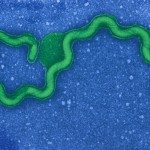Lien vers Pubmed [PMID] – 28644889
Lien DOI – 10.1371/journal.pntd.0005678
PLoS Negl Trop Dis 2017 Jun; 11(6): e0005678
Leptospirosis is a potentially life-threatening but curable zoonosis whose prognosis depends on accurate and timely diagnosis. Because of its non-specific clinical presentation, laboratory testing is essential to confirm the diagnosis. Here, we aimed to assess the performance of two enzyme-linked immunosorbent assays (ELISAs) (ELISA Serion and ELISA-Hb Pasteur) and one immunodot (GenBio) using quantitative PCR (qPCR) as gold standard, instead of the traditional microscopic agglutination test, for the diagnosis of acute leptospirosis in an endemic area.Between January 2011 and December 2012, a total of 122 patients were diagnosed with leptospirosis, as confirmed by qPCR at the University Hospital of Martinique. Among them, 103 had at least one serum sample available for analysis. Performance of each serological assay was evaluated according to days’ post onset of symptoms (DPO) and local species diversity (which included L. santarosai, L. interrogans, L. kirschneri, L. borgpetersenii, L. noguchii, and L. kmetyi). Several thresholds were tested to optimize accuracy. When considering the manufacturer’s threshold, the sensitivity of ELISA Serion, ELISA-Hb Pasteur and GenBio immunodot was 75%, 67% and 64%, while specificity was 92%, 98% and 100%, respectively. Moreover, the threshold optimization allowed a significant improvement in specificity for the ELISA Serion from 92% to 99% (p<0.05). During the first 5 DPO, sensitivities were 35%, 30% and 42% for ELISA Serion, ELISA-Hb Pasteur and GenBio immunodot, respectively. However, between 6─10 DPO, these sensitivities dramatically increased to reach 86%, 76% and 67%, respectively. Performances of the three assays were not affected by the species studied.All these serological assays showed the potential for diagnosing leptospirosis after (but not before) 6 days’ post onset of symptoms. In a high prevalence setting, where highest specificities are needed, threshold optimizing should be performed for this purpose.

